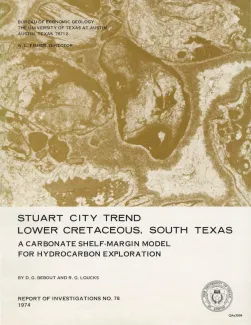
Publication Details
Geolocation:
Get the Publication
$14.00
Abstract/Description:
Lower Cretaceous shallow-water carbonates accumulated on a broad shelf which completely encircled the Gulf of Mexico. Biogenic growth climaxed along the basinward edge, or shelf margin, where a complex of reefs, banks, bars, and islands developed. The sediments reached a total thickness of 2,000 to 2,500 feet; numerous deep wells ranging in total depth from 11,000 to 20,000 feet have resulted in the discovery of a few marginally productive gas fields.
The objectives of this study are: (1) to describe the depositional facies and environments present along this trend in order to provide a model for further hydrocarbon exploration along the Stuart City Trend and also in the deeper Sligo Trend, and (2) to identify diagenetic processes which relate to porosity distribution and might lead to the discovery of zones of higher porosity elsewhere along the trend.